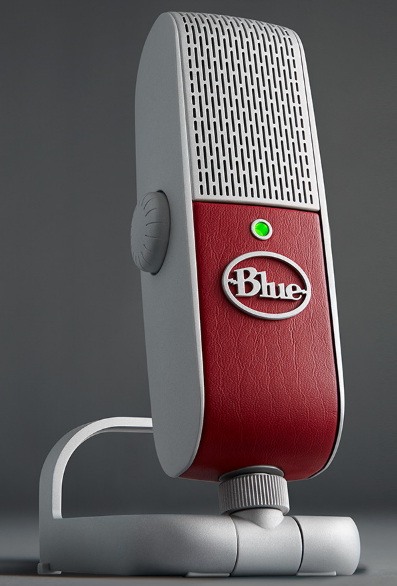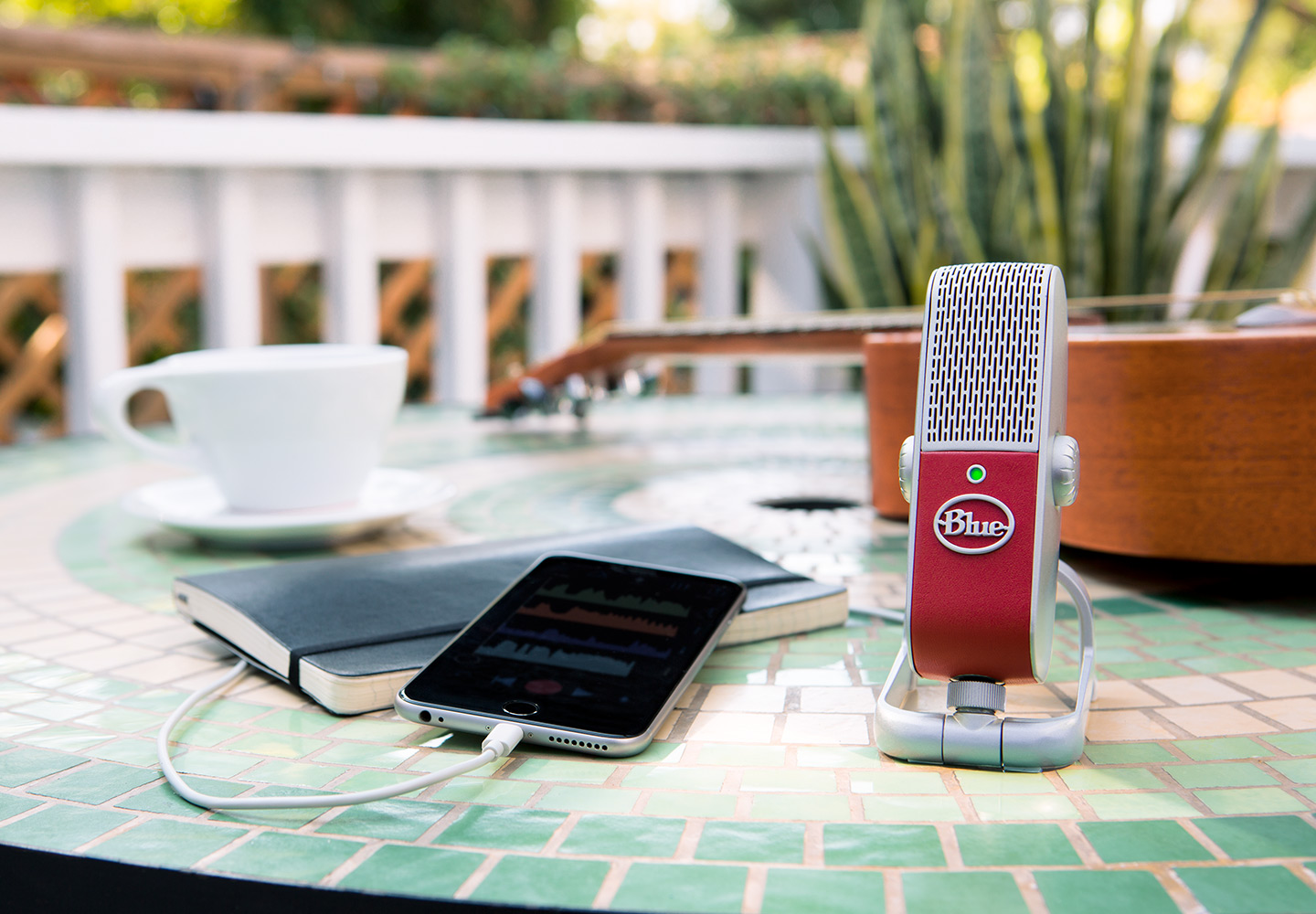New Gear Review: Raspberry USB Microphone from Blue

The collapsible cast aluminum stand wraps snugly around the Raspberry, making the mic great for portability—a great feature for those who need to capture on-the-go.
Blue has created a new USB-powered microphone for podcasters, voice-over actors, and songwriters in need of an on-the-go recording solution.
This new Raspberry mic is their most compact yet, with some new patent-pending technology under its memorable retro-futurist casing.
Features
The Raspberry is a bus-powered cardioid condenser microphone with a built-in headphone amp, featuring A/D conversion at 16 and 24-bits and 44.1 or 48kHz, with Lightning USB connectivity.
Blue has implemented their patent-pending “Internal Acoustic Diffuser” (IAD) technology, a key feature that is meant to set the Raspberry apart from other USB microphones geared toward the podcasting and portable voiceover mic markets.
The IAD technology is much like the acoustic diffusion you might see in a concert hall or recording studio. It has been designed to fit inside the microphone to help minimize the ringy or boxy sound that so often goes along with capturing audio outside of a well-treated professional studio environment. Through this feature, Blue claims the mic should allow for a clearer, more present and more focused-sounding recording, regardless of the limitations of the room itself.
Right out of the box you will notice that a single knob is affixed to either side of the mic—one for input gain on the right-hand side, and one for headphone volume on the left-hand side. On the back of the mic you’ll find a headphone jack for zero latency monitoring during recording, and a Lightning USB port for connecting the mic to your phone, tablet, or computer. Blue has included both cables for this, so you can get going right out of the box. However, if you are using an older model Apple device with a 30-pin cable, you will need to seek out an adapter. Blue has also included a soft-suede carrying pouch to protect the mic during transportation.
The Raspberry also comes equipped with a good-quality, sturdy aluminum stand. When not in use, the stand folds around the front of the mic for easy portability, keeping the microphone’s profile sleek and compact in transport.
What you might not notice at first is that there are actually rubber feet built into the stand’s design, allowing for the stand to not only sit securely in place, but to also act as a form of shock absorption.
The stand is also detachable, and the mic’s 1/4” thread mount allows you to attach it to various camera and video tripods, as well as to the included mic stand adapter for more traditional applications.
In Use
I tested the Raspberry using both the RØDE Record App and the Take Creative Vocal Recorder App on my iPhone 6, in order to get a feel for the true potential of its “on-the-go” capabilities.
As a bus powered mic, the Raspberry really isn’t too taxing on your device’s battery. I used the microphone for about two hours in one sitting, with the wifi on on my phone, and only noticed a 15% decrease in battery life. This is certainly more than enough time for the average person to record a podcast, YouTube narration, or anything similar.
Notably, when your phone sleeps, the Raspberry does as well, as indicated by the light on the front of the mic (which is green while in use). You can mute the mic by pushing the input gain knob inward, which will produce a “click,” and the light will turn red.

Blue’s IAD (Internal Acoustic Diffuser) technology helps bring a clearer, more focused tone to recordings—even when capturing in non-traditional environments.
One of the things I immediately noticed about recording with the Raspberry was the surprisingly wonderful quality of sound it produces.
It sounds akin to a decent affordable large diaphragm condenser mic, but is (obviously) much smaller in size. I would describe the sound as very present, smooth, and clear, and not quite as bright as I had anticipated. (This is probably a good thing.)
Using it on my own voice, I found there to be a good amount of detail, but without being too airy or breathy. I find that many “podcasting” microphones get this wrong. I also noticed that in terms of proximity, it sounded equally as good at desktop distance as it did closer up. This is presumably due in part to Blue’s IAD technology, which allowed for a natural and focused voice recording in a less-than-ideal space.
To be clear, IAD is not noise canceling or noise reduction technology—which can sometimes create a noticeable ducking of frequencies or introduce an unnatural quality to recordings. I was able to test the Raspberry out on ambient sound (with no narration or speaking occurring) and the results were still very focused and clear in picking up these background sounds.
To Be Critical
If I were to be critical of anything with the Raspberry, it would be some of the accessory and cosmetic details. While the grille, body, and stand are made from aluminum, the knobs are plastic and feel somewhat flimsy, so I worry about how they will hold up over time—especially considering that the carrying pouch provided is just fabric. I wouldn’t trust this pouch to protect my sunglasses, let alone such a nice microphone. After all, this mic was designed to be portable, so I was really hoping for a more protective carrying case. Perhaps Blue should consider offering a more robust option available for purchase, because this microphone is really worth protecting.
Summing it Up
Blue’s Raspberry mic offers some of the best quality I’ve found (ad some real innovation) in portable recording. The IAD technology implemented in this design allows for you to get a quality recording with a rich vocal presence, yet without so much of the obtrusive ringing or boxy room sound that often typifies podcasting, YouTube narration, and the like. At a price point of $199, this mic would be a solid investment for anyone who needs a high quality, portable device for voice recording.
Kallie Marie is a producer, composer and educator who lives in New York.
Please note: When you buy products through links on this page, we may earn an affiliate commission.








Craig Allen
May 23, 2017 at 8:23 pm (7 years ago)I wonder how this compares performance-wise to the Yeti. Anybody compared them?
Finley
July 29, 2017 at 12:52 am (7 years ago)I haven’t owned a yeti but from listening to demos I think the yeti is a bit smoother sounding. I don’t know if that has to do with dynamics or frequency but when sounds start and finisher dynamics change its maybe a little more truncated on the raspberry which I just got and have been using. The rasp sounds really good though otherwise lots of texture and I’m impressed with its dynamic range and the harmonies its picking up on my acoustic, am glad for it.
Finley
July 29, 2017 at 12:52 am (7 years ago)also vocals sound rlly good